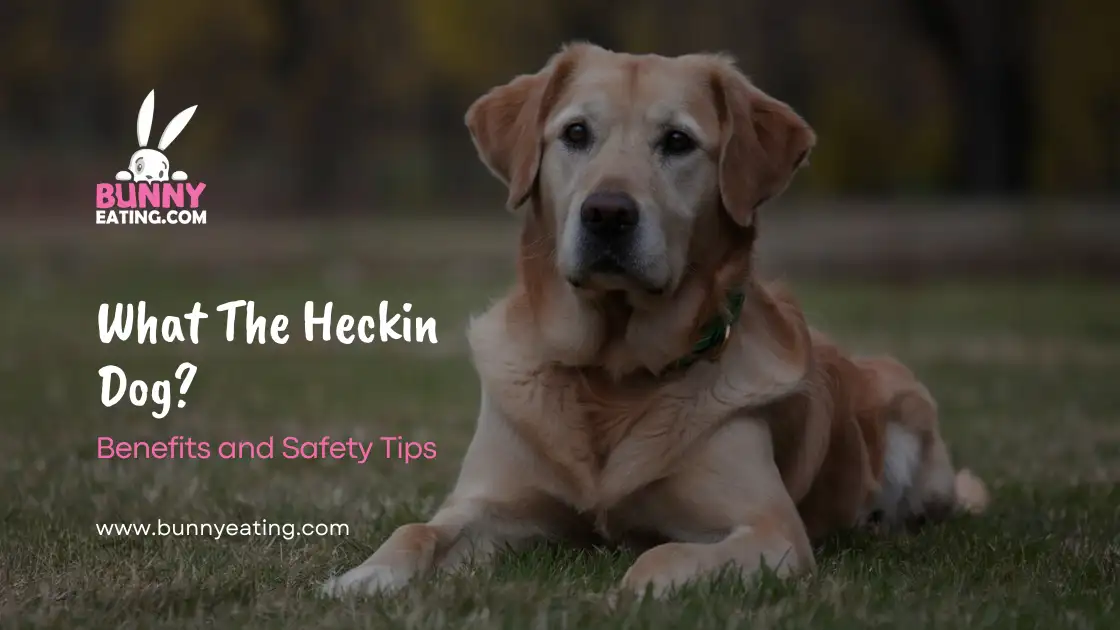A “Heckin Dog” is a playful term people use on the internet to describe their dogs. It’s a way of showing love and humour. The phrase is often seen in memes or funny dog videos.
Imagine scrolling through your feed and seeing a goofy dog doing something hilarious. That’s when people might say, “What The Heckin Dog?” It’s a phrase that adds fun and keeps things light-hearted.
“What The Heckin Dog?” has become a popular way to react to dogs being silly. It’s a mix of surprise and affection, capturing the joy dogs bring to our lives.
Origins of “What the Hackin’ Dog”
The birth of “What the heckin’ dog?” is a testament to the internet’s power to create and spread new forms of expression. This catchphrase emerged from the depths of social media, where dog lovers shared amusing photos and videos of their furry friends in unexpected situations. As users tried to capture their pets’ bewildered expressions, the phrase “What the heckin’ dog?” became a go-to caption, perfectly encapsulating the mix of confusion and adorableness that dogs often embody.
Early appearances of the phrase can be traced back to popular online forums and image-sharing platforms. It quickly gained traction as users found it to be a playful and family-friendly way to express surprise or confusion. The meme’s lineage can be linked to earlier internet phenomena like LOLcats and doge, showing how internet culture continually evolves and builds upon itself.
The Rise of Doggo Lingo
Doggo lingo, the playful language that “What the heckin’ dog?” belongs to, has become a dialect of its own in the digital world. This form of playful language goes beyond simple pet names, creating an entire vocabulary that dog lovers use to describe their furry companions’ actions and personalities. Words like “pepper,” “bork,” and “zoomies” have become commonplace, each adding to the rich tapestry of canine-inspired communication.
The appeal of doggo lingo lies in its ability to capture the essence of our relationships with dogs. It’s a language born from love, amusement, and the desire to anthropomorphize our pets. For many pet owners, using these terms feels like speaking a secret language that only fellow dog enthusiasts understand. This shared vocabulary has created a sense of community among dog lovers online, transcending geographical boundaries and cultural differences.
The Power of Positivity
At its core, “What the heckin’ dog?” and similar phrases spread joy. In a digital landscape often fraught with negativity, these lighthearted expressions offer a much-needed dose of positivity. The psychology behind cute animal content is well-documented, with studies showing that viewing adorable images can improve mood and increase productivity. By sharing funny dog moments, users aren’t just entertaining themselves; they’re contributing to a more positive online environment.
This phenomenon has brightened the internet one “pupper” at a time. It’s not uncommon to see comment sections filled with doggo lingo, creating a ripple effect of happiness. The simple act of sharing a viral video of a confused or excited dog can spark conversations, inspire creativity, and forge connections between strangers united by their love for canines.
The Meme Goes Mainstream

As “What the heckin’ dog?” gained popularity, it didn’t take long for the mainstream to catch on. Celebrity endorsements and viral moments propelled the phrase into the spotlight, with influencers and public figures incorporating it into their content. This mainstream acceptance led to a boom in dog merchandise featuring the phrase and related doggo lingo.
The integration of “What the heckin’ dog?” into pop culture has been remarkable. From t-shirts and mugs to entire product lines dedicated to the phrase, it has become a recognizable part of consumer culture. Television shows and advertisements have also embraced the trend, using doggo speak to appeal to younger audiences and pet enthusiasts alike.
Beyond the Laughs: Fostering Connection
While the humour is evident, the impact of “What the heckin’ dog?” goes beyond mere laughter. This phrase and the broader doggo lingo have played a significant role in building online communities. Social media groups dedicated to sharing dog content have flourished, creating spaces where people can connect over their shared love of canines.
Perhaps most interestingly, doggo speak has shown a unique ability to bridge generational gaps. Grandparents and grandchildren alike can bond over a cute dog photo captioned with “What the heckin’ dog?”, finding common ground in the universal appeal of adorable animals. This shared language has become a tool for digital socializing, breaking down barriers and fostering connections in an increasingly isolated world.
Reflecting on Canine Communication
While “What the heckin’ dog?” is a human invention, it’s worth considering how dogs express themselves. Canine body language is a complex system of signals that includes tail position, ear movements, and vocalizations. Understanding these cues is crucial for responsible pet ownership and building strong bonds with our furry friends.
The human tendency to anthropomorphize pets is natural and often harmless when done in moderation. However, it’s important to balance the fun of doggo speak with an understanding of real dog behaviour. Recognizing when a dog is truly confused, anxious, or in need of attention requires looking beyond the cute phrases and paying attention to their actual needs.
Cultural Impact and Social Media Phenomenon
The reach of “What the heckin’ dog?” across various social media platforms is truly impressive. Engagement metrics show that content featuring this phrase and related doggo lingo consistently performs well, garnering likes, shares, and comments at higher rates than average posts. This popularity has led to numerous case studies examining why certain dog memes go viral while others don’t.
One particularly striking example is the case of “Bork,” a Shiba Inu whose confused expression captioned with “What the heckin’ dog?” garnered over 2 million likes on Instagram in just 24 hours. This viral sensation sparked a trend of users recreating the image with their pets, further cementing the phrase in internet history.
Educational Spin-Offs and Advocacy
Beyond entertainment, “What the heckin’ dog?” has found unexpected uses in education and advocacy. Animal welfare organizations have leveraged the popularity of the phrase to promote pet adoption and raise awareness about issues facing animal shelters. By using familiar and engaging language, these groups have been able to reach wider audiences and spark important conversations about responsible pet ownership.
Veterinary clinics have also jumped on board, using doggo lingo in their outreach efforts to make pet health information more accessible and engaging. This approach has been particularly effective in encouraging regular check-ups and preventive care among younger pet owners who respond well to this style of communication.
Global Spread and Linguistic Diversity
The appeal of “What the heckin’ dog?” knows no borders. As the phrase spread globally, it underwent fascinating translations and adaptations. In Spanish-speaking countries, “¿Qué rayos, perro?” became a popular equivalent, while French speakers adopted “Quoi de la heckin, chien?” These variations showcase the phrase’s versatility and its ability to resonate across cultures.
The cross-cultural appeal of doggo speak has led to interesting discussions about linguistic diversity and the universality of certain emotions and expressions. Researchers have noted how the core sentiment behind “What the heckin’ dog?” – a mixture of surprise, amusement, and affection – seems to translate well across languages and cultures.
The Evolution of Doggo Lingo and Internet Culture

Tracing the evolution of internet language from LOLcats to doge and now to modern doggo speak offers fascinating insights into how online communication evolves. Each iteration builds on the last, refining and expanding the ways we express ourselves digitally. “What the heckin’ dog?” represents a current peak in this evolution, combining humour, affection, and a touch of absurdity.
The impact of doggo lingo on everyday communication can’t be overstated. Words and phrases that originated in dog memes have found their way into casual conversations, both online and offline. This phenomenon raises interesting questions about the future of language and how internet trends shape the way we speak and write.
The Influence on Pet-Friendly Work Environments
The popularity of “What the heckin’ dog?” has had an unexpected influence on workplace policies. As the phrase and related content gained traction, many companies recognized the morale-boosting potential of incorporating pet-friendly elements into their culture. This has led to an increase in “Bring Your Dog to Work” days and even permanent pet-friendly office policies.
Balancing professionalism with the playfulness of doggo speak has become an interesting challenge for HR departments. Some companies have embraced the trend fully, incorporating dog-themed language into internal communications and team-building activities. Others have found more subtle ways to acknowledge the phenomenon, such as featuring pet photos in company newsletters or social media accounts.
Educational Platforms and “What the Heckin’ Dog”

The educational potential of “What the heckin’ dog?” and doggo lingo has not gone unnoticed by academic circles. Linguists and sociologists have begun studying these phenomena as examples of rapid language evolution in the digital age. Some universities now offer courses that examine internet memes and their impact on communication, with doggo speak serving as a prime case study.
Language learning platforms have also caught on, using popular dog memes to teach idiomatic expressions and cultural references to English language learners. This approach has proven effective in engaging students and helping them understand the nuances of online communication in English-speaking countries.
Conclusion
“What The Heckin Dog?” is a phrase that adds fun to the way we talk about dogs. People use it to show how much they enjoy and love their dogs. It has become very popular, especially online, where many people share funny stories and videos of their pets. This phrase helps us connect with others who love dogs and want to share in the joy they bring.
Understanding “What The Heckin Dog?” also shows how much language can change to express our feelings. This phrase might seem silly, but it means a lot to those who use it. It’s a way to celebrate the happiness that dogs bring to our lives. Whether online or in conversation, it’s a fun and light-hearted way to talk about our furry friends.
FAQs
What is the heck in dog language?
“Heck” in dog language is a playful term people use to express surprise or mild disbelief when talking about a dog’s silly or unexpected behaviour.
What does heckin doggo mean?
“Heckin doggo” is an affectionate and humorous way to describe a dog, often used in memes to highlight a dog’s cute or funny actions.
What’s Hello in Dog Language?
In dog language, “Hello” is often expressed through wagging tails, excited barks, or friendly nudges, showing their eagerness to greet you.
What is the dog from the meme?
The dog from the meme is often referred to as “Doge,” a Shiba Inu known for its expressive face and colourful captions in broken English.











